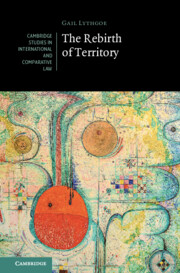Book contents
- The Rebirth of Territory
- Cambridge Studies in International and Comparative Law: 186
- The Rebirth of Territory
- Copyright page
- Contents
- Acknowledgements
- Table of Cases
- Table of Treaties, Resolutions, and Acts of International Organisations
- Abbreviations
- 1 Introduction
- 2 Deterritorialisation Discourse in International Law
- 3 Excavating the Territory of International Law
- 4 Re-imagining the Concept of Territory
- 5 Reterritorialising International Law
- 6 A New Legal Geography for International Law
- Bibliography
- Index
- Cambridge Studies in International and Comparative Law
3 - Excavating the Territory of International Law
Published online by Cambridge University Press: 07 March 2024
- The Rebirth of Territory
- Cambridge Studies in International and Comparative Law: 186
- The Rebirth of Territory
- Copyright page
- Contents
- Acknowledgements
- Table of Cases
- Table of Treaties, Resolutions, and Acts of International Organisations
- Abbreviations
- 1 Introduction
- 2 Deterritorialisation Discourse in International Law
- 3 Excavating the Territory of International Law
- 4 Re-imagining the Concept of Territory
- 5 Reterritorialising International Law
- 6 A New Legal Geography for International Law
- Bibliography
- Index
- Cambridge Studies in International and Comparative Law
Summary
This chapter gets to the heart of why the disciplinary imagination of international law is only able to see deterritorialisation without reterritorialisation, by excavating the content of the orthodox concept(s) of territory and scrutinising the spatial assumptions. For it is how territory is understood that forces the production of aterritorial functionalist account of law. The chapter reviews the standard definition(s) of territory before deconstructing the characteristics and qualities of the concept of territory. These include: that territory is only states’; that territory is imagined in a two-dimensional, flat, jigsaw-like form; that the physical referents are analytically prioritised over the social; that territory tends to be imagined as homogeneous, uniform, and contiguous ; that territory is bound by a particular technology and representation of borders; and that territories are relatively static. The final sections delve into the signification of territory and outline five different uses for territory in the discourse, before exploring how territory has mediated legal theoretical understandings of sovereignty.
Keywords
- Type
- Chapter
- Information
- The Rebirth of Territory , pp. 71 - 142Publisher: Cambridge University PressPrint publication year: 2024



